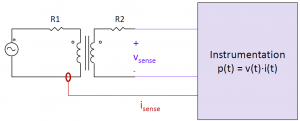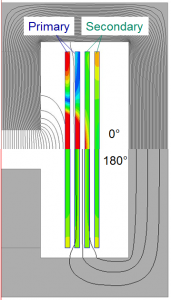At APEC 2017, we presented a high-Q resonator with a multi-layer winding and integrated capacitance for resonant power conversion.
A low-loss inductor winding for MHz frequencies can be built by connecting in parallel multiple layers of foil conductors much thinner than a skin depth. To ensure approxim ately equal current sharing among layers, a capacitance can be inserted into each layer as shown in the figure; this is similar to twisting the litz wire for equal current sharing among wire strands. This capacitance can also be used for resonance, which eliminates the need for additional lumped capacitors and connection between capacitor and inductor.
ately equal current sharing among layers, a capacitance can be inserted into each layer as shown in the figure; this is similar to twisting the litz wire for equal current sharing among wire strands. This capacitance can also be used for resonance, which eliminates the need for additional lumped capacitors and connection between capacitor and inductor.
We developed a method to implement this multi-layer winding by using copper laminated on polyimide substrates for ease of handling. The orientation of copper layers adjacent to the polyimide substrate ensures that there is no significant electric field, and hence low effective loss, in polyimide. The required capacitance for each layer is provided by free-standing PTFE films. The prototype of this resonator at around 8 MHz have a quality factor around 830 in under 15 cm3, 50% higher quality factor than an inductor with a single-layer thick foil winding connected to low-loss ceramic capacitors.



